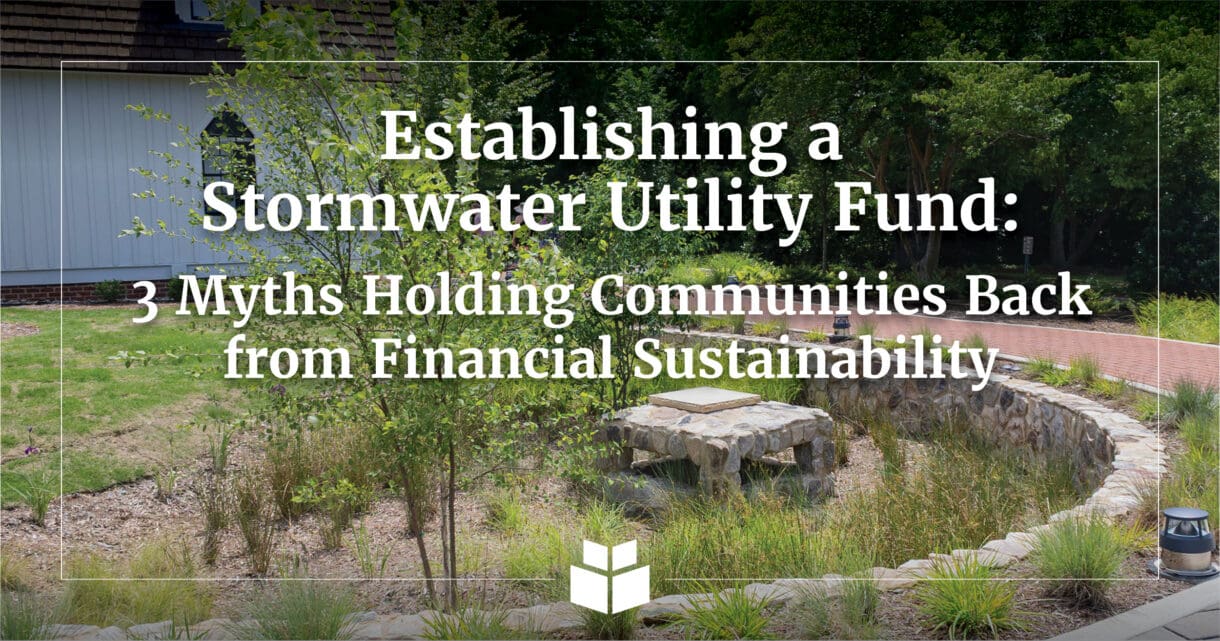
“A stormwater utility fee is just another tax.” Does this sound familiar? According to the University of North Carolina School of Government’s Environmental Finance Center, only about 20% of local governments in North Carolina have a stormwater utility, so it’s no wonder that stormwater utility fund myths abound.
The truth is that a stormwater utility fund is an enterprise fund that provides local governments with a financial mechanism to pay for stormwater maintenance, repairs, and capital improvements or replacements—it’s no different from a water or wastewater utility. An effective stormwater utility fund balances present operational costs and future capital investments without placing an undue burden on users.
If a stormwater utility fund is so sensible, then what’s holding communities back from creating one? Here are three myths about establishing a stormwater utility fund and the realities they conceal.
Myth #1: Small communities do not need a stormwater utility fund
For a small community, establishing a stormwater utility fund may seem at first blush like an unnecessary expense. There is the upfront cost of gathering data and preparing a financial model to create the utility, and then the ongoing administrative costs of issuing bills, collecting payments, and investigating disputed charges. Why not take the money spent on these tasks and put them toward stormwater projects directly?
Additionally, small communities may worry that even if they successfully establish a stormwater utility, their modest population combined with a reasonable fee structure will never net them enough funds to finance a large capital project. What is the point of collecting fees if they will not cover the cost of significant improvements?
While these are valid concerns, it is important to reframe the thinking around a stormwater utility fund from an instant solution to an incremental improvement.
A stormwater utility fund may not fund a large capital project, but it could fund a stormwater study or pilot project. The data gathered during this smaller initial project could support a funding application, providing the justification for funds for a larger project.
In that same vein, a stormwater utility fund does not need to be one hundred percent self-sustaining immediately. Instead, by covering the costs of smaller maintenance and repair projects every year, the stormwater utility fund frees up general fund dollars that had been paying for this kind of work, giving the local government more flexibility when financing capital improvements.
A stormwater utility fund makes it possible for small investments to snowball into bigger changes.
Myth #2: Communities in the same county or watershed can use the same rate structure
Given the effort and upfront cost involved in establishing a stormwater utility, it is tempting for communities to look to their neighbors for a ready-made solution. If a nearby city or town has established a stormwater utility fund and published their rates, why not save time and money by copying an already successful structure?
This may provide some benefits in the near term, but there are two reasons why this does not tend to be effective over a longer period: different distributions of user types and sizes, and different community needs and goals.
Different distributions of user types and sizes
Imagine that in Community A, the highest stormwater fee tier is occupied by a large industrial site or logistics hub. Meanwhile, Community B has no single large runoff contributor, but many mid-sized businesses and small to medium-sized homes.
If Community B simply copies Community A’s rate structure, then they may end up overcharging or undercharging their customers. Overcharging is likely to make everyone unhappy and discourage future growth, while undercharging means not bringing in enough funds to achieve the community’s desired level of service or financial goals.
An effective stormwater utility fund sets tiers and rates based on both the current distribution of users and future projections, taking into account any plans for economic development.
Different community needs and goals
Because the purpose of a stormwater utility is to fund stormwater maintenance, repair, and improvement projects, the makeup of the stormwater system matters. A community with a newer system is likely focused on annual preventative maintenance projects, while a community with an aging or damaged system may need to fund more extensive repairs or replacements.
Likewise, the makeup of the community matters, especially when communities may be working with very different demographics than their neighbors. One community may have a large population of part-time residents and tourists, while another may have a higher proportion of households with low or fixed incomes, and yet another is primarily a business center with many commuters but few residents.
Together, these categories multiply to create a huge variety of combinations, and a stormwater rate structure that works well for one community may not be feasible at all in another.
Imagine Community C is a suburban town with a large cohort of retirees and a deteriorating stormwater system, and Community D, their urban neighbor, has run a successful stormwater utility fund for a decade and has ambitions to expand.
Community C would certainly benefit from establishing a stormwater utility, but if they suddenly adopt the rate structure of Community D, they may place an undue burden on residents. If they were to develop their own rate structure instead, they could explore a slow ramp-up in fees over time, allowing everyone to adjust to the change while still meeting the community’s stormwater goals.
Myth #3: Communities can use aerial imagery to measure impervious areas and set rates, thereby foregoing a full rate study
To save communities time and money upfront, some companies offer a shortcut to establishing a stormwater utility: instead of conducting a full rate study, they use aerial imagery to measure impervious areas, and then recommend rates based on the amount of impervious area identified. They do not address different user types, nor do they consider the financial impact of the recommended rates.
Aerial imagery is an important tool in the stormwater management toolbox, but an impervious area analysis is only a fraction of the stormwater utility fund picture. Without a rate study, there is no way to know whether the suggested rates represent a fair distribution of costs among user groups, or how close the rates come to meeting the community’s level of service and financial goals.
Establishing a stormwater utility fund is not about bringing in as much money as possible, it is about matching income to expenses. A rate study conducted by a qualified financial professional enables a community to charge customers a fair price for the cost of providing stormwater services.
The bottom line
Communities do not provide water or sewer services for free, but instead seek to set reasonable rates that allow them to deliver these services sustainably long-term. Establishing a stormwater utility fund is about applying the same framework used for water or wastewater to stormwater.
Luckily, financial modeling for stormwater is simpler than modeling other wet utilities, and our financial professionals have completed stormwater financial modeling for North Carolina communities at all sizes. We can help you break down barriers around establishing a stormwater utility fund and achieving your stormwater goals.

